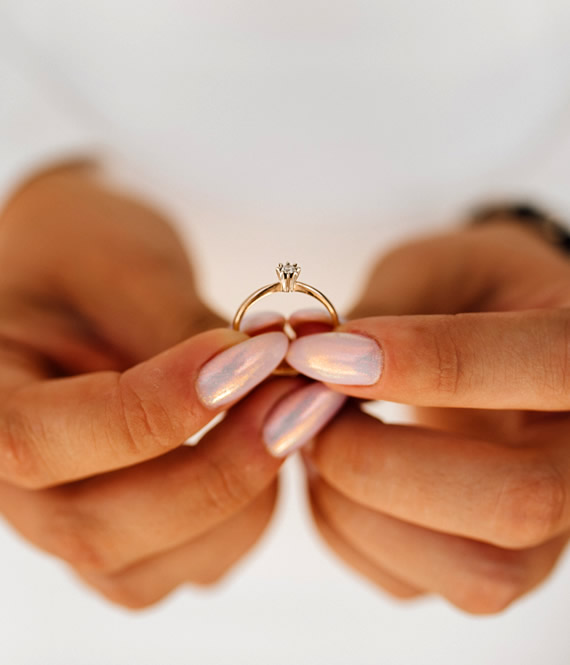
Lab-Created Diamonds: 6 Pros, Cons & Are They a More Ethical Way To Get Jewelry?
We recommend helpful products in our articles. Read our full disclosure here. The content on this website is not intended to be a substitute for professional advice, diagnosis, or treatment.
In the world of jewelry, more and more consumers are opting for lab-created diamonds over mined diamonds.
Lab-made diamonds are fabricated in a lab setting, allowing consumers to purchase a beautiful and unique gem at a fraction of the price of a mined diamond.
But lab-created diamonds don’t come without their own pros and cons that consumers must consider.
There are certain advantages and disadvantages that come with purchasing a lab-created diamond, and these must be taken into account before making a final purchase.
If you’re in the market for a new diamond, it’s essential to consider all the factors before making a decision.
In this article, we’ll share the pros and cons of choosing lab-created diamonds.
What are Lab-Created Diamonds?
Lab-created diamonds are diamonds made in a controlled lab environment.
These diamonds are made using a process called chemical vapor deposition (CVD) or high-pressure high-temperature (HPHT).
Both processes use carbon, the building block of mined diamonds.
As a result, lab-created diamonds have the same properties and qualities as mined diamonds but at a much lower price.
Lab-made diamonds are seen as a great alternative to mined diamonds, especially for those on a budget or those wanting to purchase a zero-emission gem.
Lab-Made Diamond vs. Gem Simulant: What’s the Difference?
While consumers often confuse diamond simulants for lab-grown diamonds, they aren’t the same.
Diamond simulants, like cubic zirconia or moissanite, aren’t carbon-based, but lab-grown diamonds are.
Crystals cut in the shape of diamonds are either made of glass or plastic.
If you want to get a true lab-created diamond, you’ll need to go to an experienced jeweler.
For example, you can get your perfect lab-grown diamond at VRAI.
VRAI-created diamonds are timeless and modern, grown in a zero-emission foundry, and purchased according to the shape, setting, or design you desire.
But if you purchased a gem simulant or a manufactured crystal instead, you won’t receive any of these benefits.
Lab-created diamonds last just as long as mined diamonds and can be grown in zero-emission foundries.
The same can’t be said for plastic or glass-made crystals.
The Advantages of Lab-Created Diamonds
If you purchase a lab-created diamond, you’ll receive a whole host of benefits.
Before we look at the potential downsides of purchasing a lab-made diamond, let’s look at the many positives.
1. Lab-Grown Diamonds Cost Less Than Mined Diamonds
Lab-grown diamonds are often seen as an affordable alternative to mined diamonds.
With a lab-made diamond, you could get the same look and sparkle as a mined diamond without spending as much.
Lab-created diamonds typically cost 30 to 40% less than mined diamonds.
The lower cost of lab-created diamonds can make them an attractive option for someone searching for a diamond on a budget, as they look virtually identical to mined diamonds.
2. Lab-Grown Diamonds Don’t Require Mining
One of the biggest advantages of lab-grown diamonds is that they don’t require mining.
Mined diamonds have to be mined from the Earth’s surface.
This process damages the environment, leads to a high carbon footprint, and doesn’t always guarantee a diamond of superior quality.
On the other hand, lab-grown diamonds are made in a lab setting that maintains strict quality control.
Consumers are certain to get a high-quality gem without having to damage the Earth.
3. Lab-Grown Diamonds Are as Strong as Mined Diamonds
Lab-grown diamonds have the same chemical and physical properties as mined diamonds.
This means that they are just as strong and durable and contain the same sparkle and brilliance.
On the inside and out, lab-grown diamonds are exactly the same, as they’re made of the same stuff.
When shopping for a lab-created diamond, you can be sure that you are investing in a beautiful gem that’s of the highest quality and is just as durable and precious as a mined diamond.
The Disadvantages of Lab-Created Diamonds
While there are disadvantages to purchasing lab-created diamonds, many of them can be turned into positives or aren’t as bad as they seem.
Here’s the downside to lab-grown gems.
1. Lab-Grown Diamonds Don’t Hold Their Value
The biggest drawback of a lab-grown diamond is that it doesn’t hold its value.
However, mined diamonds don’t typically sell for a profit.
While many would consider mined diamonds a good investment, that’s only if the gem is rare.
Mined diamonds are more associated with opulence, which may turn people away from lab-grown diamonds.
With that said, no one can actually tell the difference between the two.
Turn a negative into a positive: Don’t buy a diamond as an investment.
Diamonds don’t go up in price as much as people think, and there’s no guarantee you’ll get your money back.
2. Lab-Grown Diamonds Take Jobs Away From Developing Countries
A lab-grown diamond is always considered “ethically sourced” because you don’t have to disturb any land surfaces or produce any waste.
With that said, some critics of lab-grown diamonds state that the industry is taking away work from miners in developing countries.
While this is true, many diamond mines are rife with poor labor practices.
Mining is also incredibly dangerous, especially if the mining company doesn’t supply proper equipment.
Turn a negative into a positive: Buying a lab-grown diamond is still an ethical win, but people who are truly invested in the rights of workers should lobby for better conditions overseas.
3. Lab-Grown Diamonds Have Their Own Environmental Issues
Another criticism of lab-grown diamonds is that they may not be truly zero-emission.
While this is technically true (you need the energy to run the diamond-making machines), the emissions produced by lab-grown gems are nowhere near the ones created by mined diamonds.
It’s also possible to use a renewable energy source that can supply laboratory machines with electricity.
On the other hand, it would be impossible to remove all carbon produced by mines.
Turn a negative into a positive: Lab-grown diamonds are an eco-friendly choice when compared to mined diamonds.
Just make sure you’re buying from an eco-friendly company.
Choose diamonds from zero-emission diamond foundries that are powered 100% by hydroelectric or solar power.
"We love to research problems, examine studies, analyze solutions, and share with you ideas that make life healthier. You can learn about us and our editorial standards here. Have suggestions or feedback to share? Send us a message!."













Leave a Comment